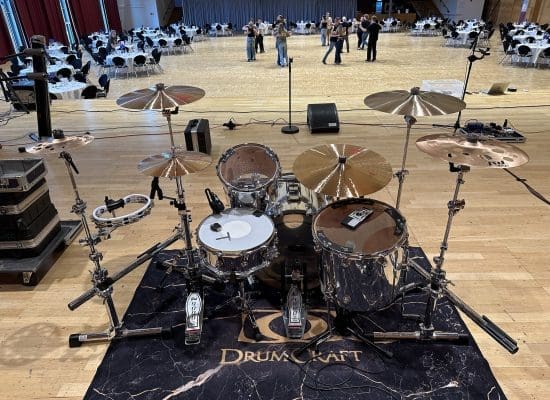Feature photo: View from Berliner Platz to Sülmerstraße (2018)
In prehistoric times, ancient long-distance routes met near Heilbronn, crossing the Neckar, a river that was still very wild and almost insurmountable at the time, or coming from the Alps and continuing along it into the North German lowlands.
Like the Celts before them, the Romans also settled in the area in order to use and secure both crossings and roads. The latter also recognized that the hills to the right of the Neckar were well suited for viticulture.
For the first time Heilbronn is written as villa Helibrunna Mentioned in a donation dated 741. The name points to a well or a spring and thus gives the settlement its current name. It is assumed that this is one Frankish royal court acted, which was at the Neckar crossing of the Franconian royal road, which was called "Alte Hällische Straße", and after Schwäbisch Hall led.
And already at this time one can define the future Sülmerstraße as a section of a long-distance route along the Neckar, precisely from this fountain in a northerly direction to the crossing of the pfelbachs, shortly thereafter at today's Bulwark Tower in the Neckar flows. The street got its name because it was the next after Sulm, today's Neckarsulm, leads.
Already 1050 becomes a Markt in Heilbronn confirmed what is definitely a first step towards city and the port is mentioned as early as 1140, which shows that in Heilbronn not only land routes were used. When Heilbronn was first referred to as an oppidum, a fortified city, in 1225, the Sülmerstraße was now also an integral part of the city, probably located on the first city fortifications, but later that part of the trade route that runs through the whole of Heilbronn as a north-south axis , at the Sülmertor begins until today Kilian's Church enough and then there as Flein Street up to Flein Gate is continued. A west-east axis that is a matter of course today, the Kaiserstrasse, did not exist at that time, only the Kramgasse from the Kilianskirche westwards to a fortified Neckar crossing, including its own town gate. It was not until 1776 that what was then Kramgasse was expanded into a chaussee and in 1897 it was renamed Kaiserstraße. The Kaiserstraße still marks the dividing line between two different parts of the former old town of Heilbronn.
It is interesting that initially the slightly higher southern part of the city with the properties of the Teutonic Order, the Kilianskirche and the first town hall there formed the urban focus. The northern part was probably only added around 1200 as a deliberate expansion of the city and from the beginning was reserved for crafts, trade and the Jewish fellow citizens. It was not until 1535, when the town hall burned down near the church fountain, that the town hall was moved together Marketplace to the northern part of the city, which over the centuries has developed more and more around Sülmerstraße.
Around 1333 they were still moving there Altbockinger added, who had previously left their own village. They probably also used the chapel of St. Nicholas, today's one Nikolaikirche, which was first mentioned in 1351 as their own place of worship; At that time, this was still operated as a so-called branch church to the existing Kilianskirche, which was documented in 741 and again in 889. Incidentally, the Nikolaikirche on Sülmerstrasse became the first Reformation church in Heilbronn in 1525 and, among other things, in the following years Zeughaus, simple armory and gym, depending on the current needs of the people of Heilbronn. It is currently being rebuilt again and given another purpose.
The one adjacent to Sülmerstrasse pebble market was in the late Middle Ages with the synagogue from the year 1357, the ritual baths and its own cemetery, the center of the Jewish community in Heilbronn, which Lamb- and the Judengasse, today's Lohtorstrasse, had its own main axes. After the city ban on Jews in the late 15th century, the entire site was built over.
The one that still exists today harbor marketplace was built in 1593 on the site of an old cemetery and received a fountain, which was initially dated Cecilia fountain and last from well was fed from and thus ensured the water supply for the residents there. The one created in 1955 at the old place Harbor Market Fountain served us children next to the two wells of the Berlin Squarenot only for summer refreshment but, in contrast to the other two fountains, also had playful value in winter.
But as early as 1487, in the immediate vicinity (pebble market?) port market pottery have been sold.
Today's Harbor Market Tower reminds of the former Franciscan monastery, which was consecrated in 1314 St. Mary's Church burned down 1688; only said tower was rebuilt between 1698 and 1727, funded by donations. The monastery had already been closed in 1544 after the people of Heilbronn had managed to scare away the last monks from there. The monastery building became a Latin school, then that Karlsgymnasium, today's Theodor Heuss High School, which is no longer on Sülmerstraße, but now on the Karlstrasse lies.
North of Sülmerstraße, am pfelbach near the Sülmertor and outside the city walls, at the end of the 13th century, there was also the first verifiable Heilbronn facility for nursing, namely the special infirmary at St. Jakobus am Graben with its own chapel and cemetery. His storehouse and administration were in the Jakobsgasse within the city walls.
Sülmerstraße itself was a very busy street from the start and has had a lot to offer over the centuries; one even ran through them once Tram. Its most well-known resident today is probably the doctor Robert Mayer to have been from 1842 until his death in 1878 Kirchhöfele worked and lived.
The Knight canton of Kraichgau had his archive at Sülmerstraße 40, the location of the former horse mill. The choice of location for the knighthood was perhaps also due to the fact that the most famous Heilbronn inn in the 18th century, namely the inn to the sun, was located not far from Sülmerstraße 52; even Johann Wolfgang von Goethe was a guest there.
It should not go unmentioned that as early as the beginning of the 20th century at Sülmerstraße 54 the Tropical fruit shop Lidl & Co. was based, which today as the Schwarz Group is one of the world's leading food retailers, but was driven out of Sülmerstraße by the competition.
From today's northern end of Sülmerstraße, the Berlin Square, there is hardly anything to see today, meanwhile that dominates K3 with cinema, library, music school, comedy house, restaurants and shops the former Torplatz; also its two wells were removed and replaced by one theater fountain before the new one city Theater replaced. only the tower road towards the Bulwark Tower continues to wait for a renovation - the previously announced exposure of the pfelbachs should, however, be off the table by now.

But the building still stands todayHeilbronner Hof“ at Sülmerstrasse 57, which my grandfather had built on the corner of Turmstrasse in 1952/1953; before that, right after the war, he had the restaurant "Sülmertorbuilt and operated. The Heilbronner Hof provided later than Roxy caused a sensation in Heilbronn and was obviously too much of a good thing for many people in Heilbronn.
I myself grew up in the 1960s in one that later stood next to it commercial and residential building in Sülmerstraße and I still like to remember their diversity and busyness.
Later, the Sülmerstraße as "Sulmer City’ has developed its own brand core and is attempting to counteract the dwindling city center attractions that can be observed around the world with a variety of campaigns.
In the meantime, the Sülmerstraße with the Lower Neckarstrasse, posing as part of Neckar Mile marketed and the prettified one avenue get two parallels that also try to reinvent themselves. In my opinion, however, this can only be achieved together and must therefore be Overall concept "North downtown“ be rethought and, above all, actually implemented.
"Faithless is he who says farewell when the street grows dark."
JRR Tolkien, The Lord of the Rings







